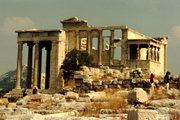Erechtheum
|
|
Acropolis_of_Athens_01359.JPG
Acropolis_of_Athens_01360.JPG
The Erechtheum, or Erecththeion, is an ancient Greek temple on the north side of the Acropolis of Athens in Greece, notable for a design that is both elegant and unusual.
The temple as seen today was built between 421 BC and 407 BC, but it is believed to be a replacement for an older temple, since it is on the site of some of the most ancient and holy relics of the Athenians:
- the Palladion, which was a xoanon (wooden effigy) of Athena Polias (Protectress of the City) that fell from heaven according to myth
- the tomb of Cecrops
- the tomb of Erechtheus
- the marks of Poseidon's trident and the salt water well (the "salt sea") that resulted from Poseidon's strike, and
- the precincts of Herse, Pandrosus and Aglaurus (the three daughters of Cecrops) and of the tribal heroes Pandion and Boutes.
Within the foundations lived the sacred snake of the temple, which represented the spirit of Cecrops and whose well-being was thought essential for the safety of the city. The snake was fed honey-cakes by the priestesses of Athena Polias, who were by custom the women of the ancient family of the Eteoboutadae. The snake's occasional refusal to eat the cakes was thought a disastrous omen.
The need to preserve multiple adjacent sacred precincts likely explains the complex design. The main structure consists of four compartments, the largest being the east cella, with an Ionic portico on its east end.
On the north side, there is another large porch with columns, and on the south, the famous "porch of the maidens", with six draped female figures (Caryatids) as supporting columns. One of the Caryatids was removed by Lord Elgin in order to decorate his Scottish mansion, and was later sold to the British Museum (along with the pedimental and frieze sculpture plundered from the Parthenon). Athenian legend had it that at night the remaining five Caryatids could be heard wailing for their lost sister. Nowadays the five original Caryatids are displayed in helium-filled glass cases in the Acropolis Museum and are replaced in situ by exact replicas.
The entire temple is on a slope, so the west and north sides are about 3 m (9 ft) lower than the south and east sides.
The intact Erechtheum was extensively described by Pausanias (1.26.5 - 27.3). The internal layout has since been obscured by the temple's later use as a church and possibly as a Turkish harem.
Ionic_base_of_a_column.jpg
References
- Pausanias
- Charles Weller, Athens and Its Monuments (Macmillan, 1913)
- G. P. Stevens and J. M. Paton, The Erechtheum (1927)
- I. T. Hill, The Ancient City of Athens (1953)de:Erechtheion
es:Erecteión fr:Érechthéion it:Eretteo (tempio) nl:Erechtheion pl:Erechtejon

